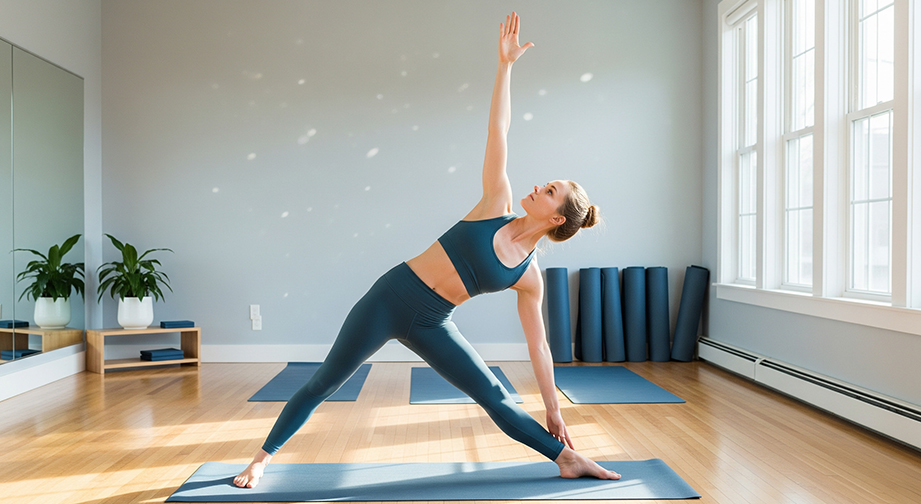Trikonasana (Utthita Trikonasana) – The Triangle Pose
Introduction
Trikonasana (pronounced tree-ko-nah-suh-nuh), also known as Utthita Trikonasana or the Triangle Pose, is a classic standing yoga posture that combines strength, flexibility, and balance in one simple move.
The Sanskrit name breaks down as: "Utthita" means “extended,” "trikona" means "triangle," and "asana" means "pose." In essence, Trikonasana is all about creating space, balance, and openness (especially across your sides and chest).
If you’ve ever felt stiff after sitting too long, this pose is your best friend. The Triangle Pose rejuvenates worn-out bodies and minds, making it both calming and energizing for any yoga practice.
Step-by-Step Guide: How to Practice Trikonasana

- Start in Mountain Pose (Tadasana):
Stand tall at the top of your mat, feet together, shoulders relaxed.
- Step your feet wide apart:
About 3-4 feet, toes pointing forward.
- Turn your right foot out:
Turn your right toes 90° to the right. Left toes slightly in.
- Raise your arms parallel to the floor:
Arms outstretched, palms facing down. Inhale here.
- Reach to the right:
On your next exhale, reach through your right hand as far as you can, shifting your hips back.
- Lower your right hand:
Bring your right hand to your shin, ankle, or a yoga block. Stretch your left arm up toward the ceiling, fingers extended. Gaze up at your top hand or straight ahead, depending on your neck comfort.
- Hold and breathe:
Stay here for 30 seconds to 1 minute, breathing deeply. Inhale to lengthen your spine, exhale to deepen the stretch.
- To release:
Inhale to come back up, arms still extended. Turn your feet to center, then repeat on the left side.
- Recommended rounds: 2-3 on each side
- Beginner modification: Place your bottom hand on a yoga block or higher on your leg. Do not strain to reach the floor.
- Advanced intensity: Deepen your stretch by lowering your hand closer to your ankle or hold your big toe with two fingers. Try looking up to your top hand for a balance challenge.
Alignment & Safety Tips
- Key cues:
- Keep both sides of your waist long—don’t let your torso collapse.
- Engage your thighs; press through the outer edge of your back foot.
- Stack your top shoulder directly over the bottom for an open chest.
- Common mistakes:
- Avoid rounding the spine—lengthen outward instead of down.
- Don’t lock your front knee; keep a micro-bend if needed.
- Don’t let the chest drop forward—keep it open.
- Safety precautions:
- If you have neck, hip, back, or shoulder injuries, avoid this pose or practice under guidance.
- Avoid if you are pregnant or have low blood pressure—stand near a wall for support if needed.
Benefits of Trikonasana (Utthita Trikonasana)
Physical Benefits
- Stretches and strengthens the legs, knees, and ankles.
- Opens the hips, chest, and shoulders.
- Enhances flexibility in hamstrings and groin.
- Improves balance and posture.
- Can help relieve lower back pain.
Mental Benefits
- Promotes concentration and body awareness.
- Relieves stress and mild anxiety with mindful breathing.
- Encourages present-moment mindfulness.
Energy / Chakra Connection
- Stimulates and aligns the Muladhara (root) and Anahata (heart) chakras.
- Balancing effect on mind and body energy.
Contraindications
- Avoid Trikonasana if:
- You have a recent or chronic knee, hip, neck, or shoulder injury.
- You are pregnant unless cleared by your doctor and with modifications.
- You have very low blood pressure. Practice with caution—consider using a wall for support.
- Safe alternative: Try a gentle side stretch seated, or Parsvakonasana (Side Angle Pose) with elbow on knee.
Beginner’s Tips & Variations
- Props: Use a yoga block under your bottom hand for extra stability.
- Gentle variation: Rest your hand higher up your shin or use the wall as support for your back.
- Advanced options: Hook your top arm alongside your ear (extended side) or hold your big toe.
{C}
How to Include Trikonasana in a Yoga Flow
- Trikonasana fits beautifully as a main posture during a standing or hip-opening sequence.
- Can also work as a warm-up for deeper standing asanas.
- Pairs well with: Warrior II (Virabhadrasana II), Extended Side Angle (Utthita Parsvakonasana), and Half Moon (Ardha Chandrasana).
{C}
Mind-Body Connection
In Trikonasana, every movement can be a mindful act. As you reach wide and ground down, focus on your breath and notice which areas open up. This pose helps create a sense of expansion and grounding, both physically and emotionally.
Chakra highlight: The Triangle Pose is believed to open and balance the root (Muladhara) and heart (Anahata) chakras, helping you feel stable yet open-hearted.
{C}
Summary
Asana Name: Trikonasana / Utthita Trikonasana (Triangle Pose)
Level: Beginner
Focus Areas: Legs, hips, hamstrings, chest, shoulders
Recommended Duration: 30 seconds to 1 minute per side
Best Time to Practice: Morning or evening, on an empty stomach
{C}
Frequently Asked Questions
Q: Should my bottom hand touch the floor in Trikonasana?
A: No, it's more important to maintain proper alignment. Place your hand on a block, shin, or thigh if needed.
Q: Can I practice Utthita Trikonasana every day?
A: Yes! Daily practice can improve flexibility, strength, and balance—but listen to your body and rest if needed.
Q: What if I feel dizzy?
A: Bring your gaze forward or down instead of up at your hand and come out of the pose slowly, resting in Mountain Pose.